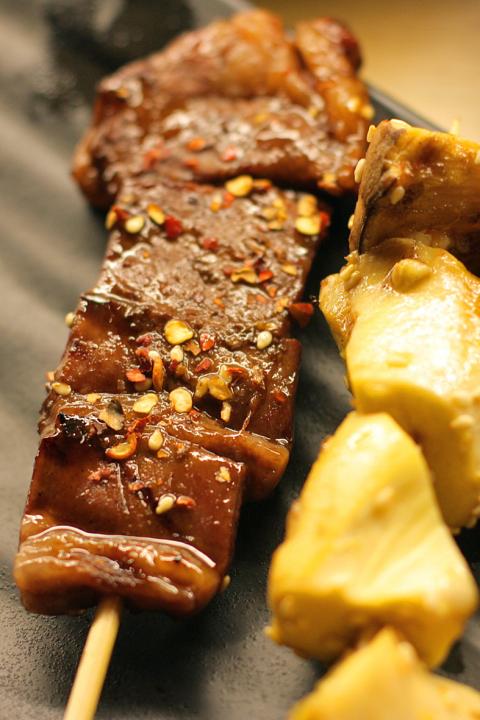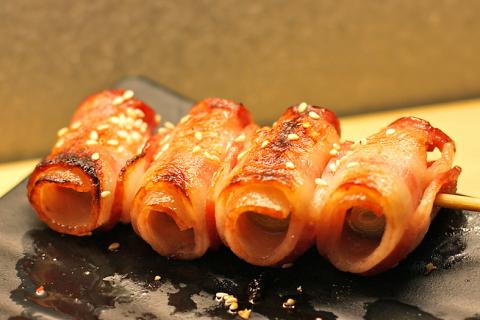Ma (麻醉坊), a yakitori restaurant that opened three months ago on Yongkang Street, packs a lot into a tiny storefront. The interior is simple, but sleekly appointed and darkly lit. Pounding dance music plays over speakers, live sports are projected onto a wall and meats are grilled in an open kitchen that looks out onto the street. Ma may not be able to decide if it is just a modern yakitori or a combination yakitori-sports bar (it offers a short menu of imported beers and cocktails), but its grilled meats are uniformly juicy and delicious.
The restaurant’s signature is a combination of spices used in Sichuan cooking, which are sprinkled over meats and mushrooms after grilling. The mala (麻辣, literally “numb, spicy”) items I had did not make my tongue tingle, but they had enough piquancy to add kick without distracting from the flavors of the beef, chicken and pork.
Many of Ma’s grilled options are on the pricey side, ranging from NT$60 to NT$80 for a single skewer. For the best value, order a set meal featuring different cuts of beef or pork. Either set costs NT$300 and includes two light appetizers, three skewers of meat, one skewer of mushrooms and a non-alcoholic drink. Ma only has one grill and even though the restaurant is small, service can be slow when the dining room is full. On a weeknight, my appetizers and cocktail arrived almost immediately, but 20 minutes passed before my first skewer of mala beef shoulder (麻辣牛肩) finally appeared. It was so tender, succulent and flavorful that it almost made up for the wait. In addition to mala spices, you can also choose to have your meat flavored with cumin or salt. The latter option is a good choice for fattier cuts, like the beef shortribs or the unappetizing sounding but delicious chicken butt (雞軟骨 — Ma calls it “chicken cartilage” in Chinese, but we know what it is), which is fatty and covered in crispy skin.

Photo: Catherine Shu, Taipei Times
Ma has several options to make sure you get some vegetables in between all the skewers of meat. King oyster mushrooms (杏鮑菇) are best when brushed with rich, creamy butter and very lightly sprinkled with sesame seeds. There are several bacon-wrapped veggies on the a la carte menu. Scallions are the classic variety, but the golden needle mushrooms have a pleasant crunch and soak up the bacon juices very well.
Ma’s appetizer menu consists mostly of simple, prepared dishes like kimchi. For something a little more special, try their honey burdock (蜂蜜牛蒡, NT$60). The root vegetable is sliced into thin pieces and lightly fried to a golden crisp before being drizzled in a luxuriant coating of honey and sesame seeds. It’s a good dish to nibble on while waiting for your skewers to finally arrive.
Ma’s beverage list includes several cocktails in addition to imported beers, but my lemon highball (檸檬 highball, NT$180) was watery. Heineken (NT$90 for 300ml) is a better bet for a hot evening.

Photo: Catherine Shu, Taipei Times

Oct. 27 to Nov. 2 Over a breakfast of soymilk and fried dough costing less than NT$400, seven officials and engineers agreed on a NT$400 million plan — unaware that it would mark the beginning of Taiwan’s semiconductor empire. It was a cold February morning in 1974. Gathered at the unassuming shop were Economics minister Sun Yun-hsuan (孫運璿), director-general of Transportation and Communications Kao Yu-shu (高玉樹), Industrial Technology Research Institute (ITRI) president Wang Chao-chen (王兆振), Telecommunications Laboratories director Kang Pao-huang (康寶煌), Executive Yuan secretary-general Fei Hua (費驊), director-general of Telecommunications Fang Hsien-chi (方賢齊) and Radio Corporation of America (RCA) Laboratories director Pan
The consensus on the Chinese Nationalist Party (KMT) chair race is that Cheng Li-wun (鄭麗文) ran a populist, ideological back-to-basics campaign and soundly defeated former Taipei mayor Hau Lung-bin (郝龍斌), the candidate backed by the big institutional players. Cheng tapped into a wave of popular enthusiasm within the KMT, while the institutional players’ get-out-the-vote abilities fell flat, suggesting their power has weakened significantly. Yet, a closer look at the race paints a more complicated picture, raising questions about some analysts’ conclusions, including my own. TURNOUT Here is a surprising statistic: Turnout was 130,678, or 39.46 percent of the 331,145 eligible party

The classic warmth of a good old-fashioned izakaya beckons you in, all cozy nooks and dark wood finishes, as tables order a third round and waiters sling tapas-sized bites and assorted — sometimes unidentifiable — skewered meats. But there’s a romantic hush about this Ximending (西門町) hotspot, with cocktails savored, plating elegant and never rushed and daters and diners lit by candlelight and chandelier. Each chair is mismatched and the assorted tables appear to be the fanciest picks from a nearby flea market. A naked sewing mannequin stands in a dimly lit corner, adorned with antique mirrors and draped foliage

The election of Cheng Li-wun (鄭麗文) as chair of the Chinese Nationalist Party (KMT) marked a triumphant return of pride in the “Chinese” in the party name. Cheng wants Taiwanese to be proud to call themselves Chinese again. The unambiguous winner was a return to the KMT ideology that formed in the early 2000s under then chairman Lien Chan (連戰) and president Ma Ying-jeou (馬英九) put into practice as far as he could, until ultimately thwarted by hundreds of thousands of protestors thronging the streets in what became known as the Sunflower movement in 2014. Cheng is an unambiguous Chinese ethnonationalist,